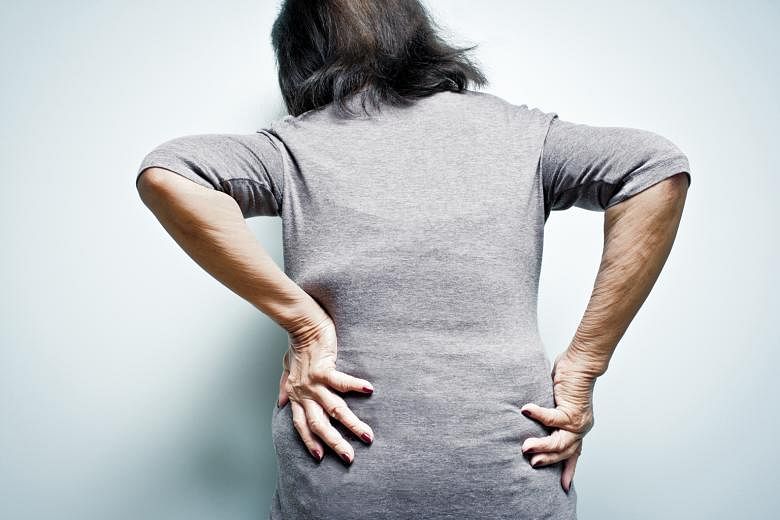Q. I'm a 60-year-old woman. I have been having hip problems for the past few months.
When I stand up after sitting in a chair for more than five minutes, I feel pain and stiffness on the sides of my hips, but especially so on the left side. After walking about for a minute or so, the pain and stiffness go away. I can't sleep on either my right side or left side any more as I would experience pain and stiffness if I lie on one side for more than five minutes. How can I alleviate the pain in my hips?
A. Pain and stiffness around the hip joint is a common complaint with fairly diverse causes.
After the age of 40, degenerative conditions such as osteoarthritis form the majority of these cases.
Osteoarthritis is a chronic joint disorder in which the cartilage lining of the joint gradually breaks down, forming cracks and holes and eventually exposing the underlying bone. Osteoarthritis is common and a leading cause of dysfunction and disability.
Consistent with your complaints, the symptoms of hip osteoarthritis include pain with activity such as walking or stair-climbing, getting in and out from a seated position and stiffness.
Other possible causes of hip pain include:
- traumatic events such as twists and falls;
- developmental problems in which the hip joint is not properly formed;
- blood circulation disorders of the hip joint, also known as avascular necrosis;
- inflammatory conditions such as rheumatoid arthritis, in which there is a chronic swelling of the joint lining which eventually damages the cartilage lining.
Occasionally, degeneration of the joints of the lower back and spine could also masquerade as a painful hip joint and this needs to be carefully excluded as a reason for your symptoms.
The general evaluation of your complaints will begin with a history-taking in which the doctor will ask questions specific to your condition and general health.
The doctor will note the duration and severity of your hip discomfort and stiffness.
Osteoarthritis usually has a protracted course with a gradual increase in severity of symptoms.
Occasionally, such symptoms may become acutely worse.
The presence of pain in other joints of the body such as the neck and spine, knee joints and small joints of the fingers and feet will also be assessed. This will aid the doctor in determining whether the disease is localised or part of a more systemic process.
Functional limitations on activities of daily living (ADLs) and the impact on quality of life will also be assessed as well as your expectations of the outcome of treatment.
This will help the doctor tailor a management plan suitable for you.
Next, a physical examination will be performed where any deformity and muscle wasting around the hip joint will be assessed.
Tenderness around the hip joint and how flexible or stiff the joint is will also be evaluated.
The examination will also include an assessment of your legs and whether there is any length difference between your legs and observing the way you walk, paying attention to the presence of any limp and muscle weakness.
Finally, an examination of the spine and circulatory and nervous systems of the lower limbs will be performed to complete the physical assessment.
An X-ray of the hip joint will generally be performed as part of your investigation workup. This will allow the doctor to have an idea of how much cartilage and bone has been worn away and the severity of any deformity of the hip joint.
Often, an X-ray of the lumbosacral spine will also be requested if involvement of the lower back is suspected. More detailed imaging via magnetic resonance imaging is occasionally requested in early degenerative disease.
If an inflammatory joint disorder is suspected, then blood tests may need to be performed.
Unfortunately, there is no cure for osteoarthritis once it is established. Treatment is then targeted at symptom control and restoration of function.
This is usually first attempted through non-surgical measures.
Patients are generally encouraged to increase their physical activity by participating in cardiovascular and/or resistance land-based activities under the supervision of a physiotherapist.
Aquatic exercises have also been shown to be beneficial if you have access to a pool.
If patients are obese, then weight loss of at least 5 per cent of body weight has been shown to have positive effects on symptoms and function. The use of hot packs and walking aids can also be considered as adjuncts to the primary treatment.
Some oral medications such as painkillers and non-steroidal anti- inflammatory drugs, as well as steroid injections, have been used successfully for symptom relief.
There is, however, little evidence to support the use of glucosamine or chondroitin supplements or gel injections for the hip.
Tai chi and acupuncture, although safe, have not been conclusively proven to be beneficial in the management of hip osteoarthritis.
Surgical intervention through joint replacement is advocated only if and when conservative means fail to achieve satisfactory symptom control.
Dr Darren Tay
Consultant in the department of orthopaedics at Singapore General Hospital
GOT A PROBLEM? E-mail your question to sthealth@sph.com.sg. Specify Ask The Experts as the subject and include your name, age, gender, identity card number and contact details.

